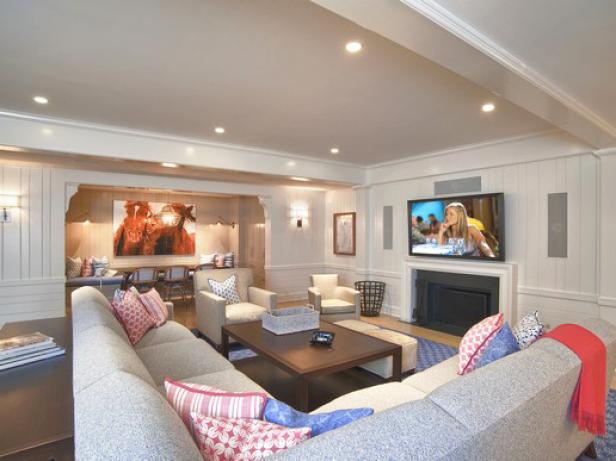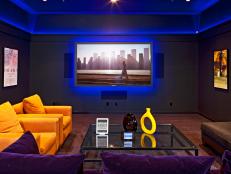How to Set Up a Media Room

HOWARD TUCKER 216-696-4616
A media room is more than just a TV slapped on the wall and speakers strewn randomly about your den. It has the potential to be an escape, a place where audio and video commingle for an amazing you-are-there entertainment experience. But when the system is powered down, the room should remain an inviting living area. This short guide will help you plan and execute an incredible space.
20 Must-See Media Room Designs
See All PhotosStep 1: Optimize your environment
One of the most important factors in your media room's performance is actually the room itself. If you have the luxury of specifying room dimensions, think rectangle. "A square room will present audio issues that may be impossible to overcome," says Bryant Moore, president of Moore Audio Design. "Even if you have to sacrifice some space to build false walls on both sides to accomplish this, it's worth it."
In terms of surfaces, materials like tile and hardwood are not ideal because they bounce sound around the room. Opt for absorptive surfaces, such as carpet, to prevent the room from sounding like a basketball court. If hard surfaces are unavoidable, you can always temper reflective materials with rugs, pillows and even acoustic treatments.
Finally, examine the amount of natural and artificial light in the room. "If you want to watch a movie in the afternoon and the sun is shining on the screen, you're missing out. Natural light should be controlled with the right window treatments. Turn lights down or off to see the full depth, range of color and contrast from your display," says Dave Ohlendorf, lead programmer at Bekins. There are some excellent lighting control systems available that you can tie into a home automation system for energy savings, remote operation and convenience.
Step 2: Get the perfect picture
The video display — the centerpiece of any system — is a good place to start thinking about equipment. "The environment will play a key role in selecting the right type of television," says Ohlendorf. There are three main technologies: LCD, LED and plasma. Generally, LCDs and LEDs are brighter, making them ideal for a room with more natural light. Plasma displays are not as bright, but provide high contrast and great black levels, creating a rich image. They also typically have better viewing angles, providing maximum flexibility for rooms with wider seating areas.
OLED — the latest in display tech — promises to be thinner, brighter and more energy efficient, but is still in its infancy. For the most cinematic image, Ohlendorf recommends positioning your seating area at a distance of 1.5 times the diagonal size of the display from the screen. If you have a larger room and want a picture above 95 inches, consider a projector and screen combo.
Step 3: Don't forget about sound
For a true media room, the built-in speakers that come with your TV simply won't do, says Moore. A 5.1 or 7.1 surround system — that's five or seven speakers plus a subwoofer — offers the most immersive experience. The biggest challenge homeowners face here is hiding wires, making it a good idea to wire for sound before drywall goes up if possible. You'll also need a receiver, which will power your speakers and handle switching between your various sources, such as a Blu-ray player and a DirecTV receiver.
For the design-minded homeowner, in-wall and in-ceiling speakers are great alternatives to freestanding or bookshelf speakers. Homeowners are increasingly opting for wireless speakers or simulated surround from a "sound bar" that sits below your TV. Both are nice aesthetic solutions, but beware of quality, which can vary wildly from model to model.
Step 4: Tie it all together
Finally, you may need a sturdy piece of entertainment cabinetry to house all your components. Look for plenty of spots for equipment, plus wire management and proper ventilation. A solid universal remote control or more robust control system is also a must for operating your system with ease and eliminating superfluous remotes from various devices.
Last, but certainly not least, a solid wireless network is increasingly important in the media room to stream audio and video to any Internet-capable device in your system and download movies from devices like AppleTV, Roku, Slingbox and Google TV-enabled devices. Many home entertainment components, like your receiver, Blu-ray player or gaming console, also connect to the Web and offer popular Internet services like Netflix and Pandora radio.







































